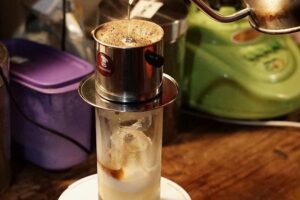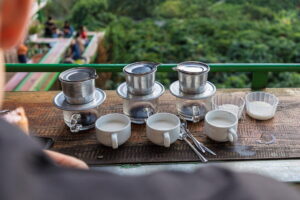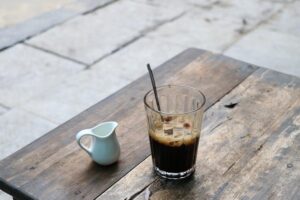Vietnamese coffee has increasingly grown in popularity and has become a favorite for many coffee drinkers around the globe. The coffee is recognized and appreciated for its distinct flavor and aroma. The unique brewing method and the condensed milk in the coffee further elevate its charm. So, what does Vietnamese coffee taste like exactly? Read on to find out!
What Does Vietnamese Coffee Taste Like?
Vietnamese coffee has a bold, bitter flavor due to the darker roast and a smooth profile. It has a natural sweetness due to the caramelization of sugars during the roasting process, with notes of dark chocolate, caramel, and hazelnuts. The coffee is traditionally made with condensed milk instead of fresh milk.

The reason for using condensed milk was the hot and humid weather of Vietnam. Condensed milk has a longer shelf life than fresh milk, and it was more easily accessible to the Vietnamese people back in the day. While you can add milk to your Vietnamese coffee, it would take away from the authenticity of the taste.
What Is the Texture of Vietnamese Coffee?
The texture of Vietnamese coffee is heavily influenced by its brewing and roasting process. It has a thicker consistency than normal coffee due to its slow-drip brewing process, which requires less water. The butter added during the roasting process is also evident in the final cup giving it a slightly oily texture.
Moreover, since condensed milk is used instead of fresh milk, the coffee retains its heavier consistency. The small coffee to milk ratio provides the Vietnamese coffee with a creamier mouthfeel that combines perfectly with the more concentrated taste.
What Kind of Beans Are Used in Vietnamese Coffee?
Vietnamese coffee is made with Robusta beans. These beans have a unique flavor profile, with an earthy body, lower acidity, and deeper mouthfeel. It is also very strong, bitter, and has a complex taste due to the high caffeine content of the beans.
Robusta coffee also has almost half the fat and sugar content of the more popular Arabica beans. Consequently, Robusta beans are considered inferior in quality to Arabica beans. Now you may be wondering if the Robusta beans are not the best variety of coffee, how can Vietnamese coffee taste so good? The secret is in the roasting process and the brewing method.
What Makes Vietnamese Coffee So Special?
Vietnam’s climatic and geographical conditions (discussed below) allowed the farmers to grow large quantities of the Robusta beans. To make the most of their coffee yield, the Vietnamese people started incorporating more flavors into the beans during the roasting process. Thus, they were able to create a better-tasting coffee from what they had available.
As I discussed above, Robusta beans are bitter with low fat and sugar content. Thus, the Vietnamese add sugar and butter while roasting the beans to give them a deeper flavor. The caramelization of the added sugar gives the Vietnamese coffee its characteristic sweetness.
Additional flavorings such as cocoa and vanilla are often introduced to help elevate and balance the taste. Finally, the beans are dark roasted to give them more bitterness and body. The roasting process is also long and slow. Consequently, Robusta coffee coming from Vietnam has a very complex and multi-dimensional taste and aroma.
People who love Vietnamese coffee appreciate the robustness of the flavor, the higher caffeine content, and the heady aroma.

What Is the Vietnamese Coffee Filter?
The next step to achieve authentic, delicious Vietnamese coffee is the brewing process. It is traditionally brewed using a Phin, which is a simple aluminum or stainless steel contraption. The Phin is placed directly on the cup, which is usually made of clear glass, so you can see as the coffee drips down into the cup.
The Phin has four parts:
- Lid: It covers the filter chamber to retain the heat during the brewing process and prevents any contaminants from entering the coffee. It is also used to catch the dripping coffee once you remove the Phin from the cup.
- Filter Chamber: It is the primary part where the main brewing process takes place. The chamber has a perforated bottom to allow the coffee to pass through while retaining the coffee grounds.
- Press Filter. It is an insert that is placed inside the filter chamber after the coffee grounds are poured into the chamber. The press filter compacts and holds the coffee grounds in place at the bottom of the chamber.
- Perforated Plate: It is placed on the cup and the entire Phin assembly (lid, chamber and insert) is balanced on the plate.
How Do You Brew Vietnamese Coffee?
The traditional Vietnamese coffee is made using a Phin, which yields one cup of coffee at a time. It is imperative to grind your coffee beans coarsely to prevent the grounds from ending up in your cup. The coarse ground also results in a longer brewing time to extract the maximum flavor from the coffee.
Here is what you need:
- 3 tablespoons of ground Vietnamese coffee (you can also use French roast coffee)
- 6 to 8 ounces of water (depending on your desired strength of coffee)
- 1 to 3 tablespoons of Sweetened Condensed milk (depending on your preference)
Stepwise instructions:
- Begin by heating the water until it is nearly boiling.
- Place the ground coffee in the Phin filter and make sure it covers the bottom evenly.
- Gently place the filter on the cup and insert the press filter. Avoid shaking or jostling the filter.
- Pour a few tablespoons of hot water into the filter chamber and wait for around 5 seconds to allow the coffee to bloom.
- Then, slowly pour the hot water into the filter chamber and place the lid on the top.
- It takes about 5 minutes for the coffee to drip into the cup.
- Once done, remove the filter and stir in the condensed milk.
Tips:
- You can warm up the cup before you begin the brewing process to maintain the coffee temperature. Simply pour boiling water into the cup and throw away the water after a few seconds
Coffee Growing Conditions in Vietnam
Vietnam is known for its coffee production around the world. Robusta beans account for around 95% of Vietnam’s coffee production, while Arabica beans make up the remaining 5%. Thus, Vietnam is the number one producer of Robusta coffee and the second largest coffee-producing country in the world.
The prevalent climatic condition and altitude make Vietnam an ideal location for growing Robusta coffee in large quantities. Moreover, the Robusta plant is easier and more sustainable to grow compared to Arabica coffee. It is also very resilient and can repel diseases, insects, and pests due to its high caffeine content.
The bulk of Vietnamese coffee is produced in the Central Highlands under the following conditions:
- The region has a tropical climate, with temperatures between 24 degrees Celsius and 26 degrees Celsius. Due to the warm weather, the farmers grow the Robusta beans under other plants to provide them with some shade.
However, the plant can survive in harsher climates, with temperatures as low as 10 degrees Celsius and as high as 30 degrees Celsius.
- Robusta beans in the Central Highlands are grown at an elevation of 300 to 500 meters above sea level. The plant can grow at varying heights, ranging from sea level to higher altitudes
- The region has high humidity and distinct dry and wet seasons; the winters are dry while the summers have heavy rainfall. The typical harvest time is between October and April.
History of the Vietnamese Coffee
Vietnamese coffee has a very interesting history. For centuries, the Vietnamese were avid tea-drinkers, similar to their Chinese neighbors. Coffee was first introduced in Vietnam in 1857 when a French missionary brought Arabica tree to Vietnam. He established a small yet successful venture to grow coffee as a cash crop.
In the early 1900s, Robusta beans made their way to the country’s Central Highlands, where the soil and the climate provided optimal conditions to grow coffee. Thus, the coffee industry boomed in the next few decades, as coffee plantations took over the Dak Lak province and the surrounding areas.
Initially, the coffee was reserved for the higher officials and selected people from the city. However, as the production grew and the yield increased, coffee was made available locally. The filtered coffee, using the Phin, quickly became a local favorite amongst the people.
In 1987, the “Doi Moi” economic reforms brought Vietnamese coffee the global attention it enjoys today. It opened the country for trade and soon Vietnam overtook Columbia to become the world’s second-largest producer of coffee. Today, the country exports 40% of the world’s Robusta coffee and 20% of the world’s total coffee production.

Vietnamese Coffee Culture
The Vietnamese coffee culture is very different from the western world. In the west, coffee is often consumed to help us wake up in the morning and get ready for a long day ahead. Moreover, a good percentage of the coffee drinkers also have a cup of joe in the afternoon or the evening for a jolt of energy.
In stark contrast to the “on the go” coffee culture of the west, the Vietnamese drink their coffee as a way to relax and unwind. They socialize with friends or sit alone without any gadgets in one of the many cafes and savor the brewing and the drinking experience.
The culture emerged partly due to the slow-drip brewing method of the Vietnamese coffee using the Phin. Usually, you get your coffee order with the Phin on the cup. Hence, you can relax while you watch your coffee drip down in a transparent vessel from the filter or have a chat with your friends.
Moreover, the cafes often do not serve any food or snacks so you can concentrate on immersing yourself in the coffee experience without any distractions. Most people have a bite to eat and then head out to the cafe for a strong and sweet cup of coffee.
Related Questions
Is Vietnamese Coffee Stronger Than Regular Coffee?
Yes, Vietnamese coffee is stronger than regular coffee due to the high caffeine content of Robusta coffee. Moreover, the coffee is brewed using a higher coffee grounds to water ratio as compared to regular coffee. Thus, on average a cup of Vietnamese coffee has caffeine levels equivalent to three cups of regular coffee.
Is Vietnamese Coffee Better Hot or Cold?
The Vietnamese coffee can be consumed hot, immediately after coming out of the Phin, or cold in a glass full of ice cubes. The taste will still be delicious and sweet, with a strong caffeine kick, as you would expect from a Vietnamese coffee. The Vietnamese people like their coffee ice cold, especially during the warm summer days.
Conclusion
Vietnamese coffee has a distinguished, concentrated taste that is strong and bitter, due to the Robusta bean and a dark roast. It also has a characteristic sweetness that comes from the caramelization of sugars during the roasting process and the addition of condensed milk. The traditional Vietnamese coffee is made using a special filter called the Phin.



